How do You Make Vinegar?
Vinegar is made via a two-part fermentation process. First, yeast consuming sugars within fruits and grains and produce alcohol; this is known as alcoholic fermentation.
Second, acetic acid bacteria consume the alcohol from step one and convert it into acetic acid. Once all the alcohol is metabolized by bacteria and converted into acetic acid, you have vinegar.
To make vinegar at home, you first essentially make wild fermented fruit wine, and then that wine turns to vinegar!


How to Make Vinegar from Fruit
It is so easy to make vinegar from fruit. You only need three ingredients: fruit, sugar, and water. It helps if you have some raw apple cider vinegar with the mother as a starter, but it is not necessary.
You can use pretty much any type of fruit to make vinegar. I suggest sticking to high fructose fruits and staying away from high-sorbitol fruits. These are two types of fermentable sugars found in fruits, and high sorbitol fruits tend to cause kahm yeast.
These are my favorite fruits to use:
- apples
- pears
- mango
- strawberry
- grape
- figs
- watermelon
- Another favorite of mine is pineapple vinegar, and I have a specific recipe for that kind, click here
To make vinegar from fruit, you just need a good bit of whatever fruit you want to use, water, and some organic cane sugar. You also need a large glass jar. For this recipe, I suggest a gallon glass jar and a cloth cover with a rubber band. You have to use a cloth lid when making vinegar because acetic acid bacteria require oxygen to convert alcohol into acetic acid. I usually make cloth lids for fermentation by cutting up old t-shirts.
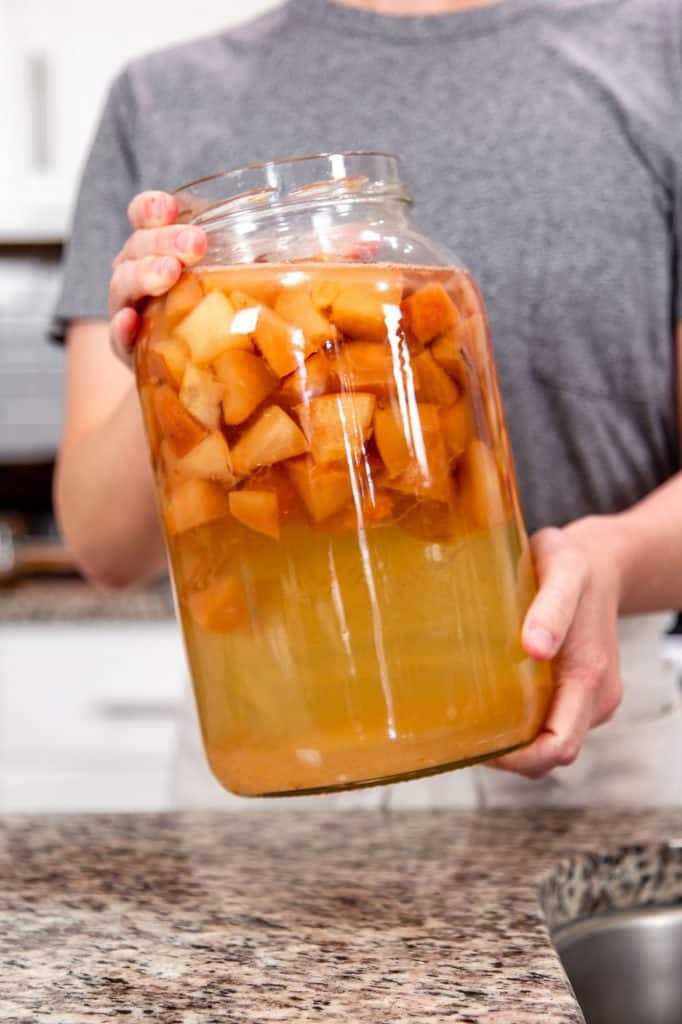
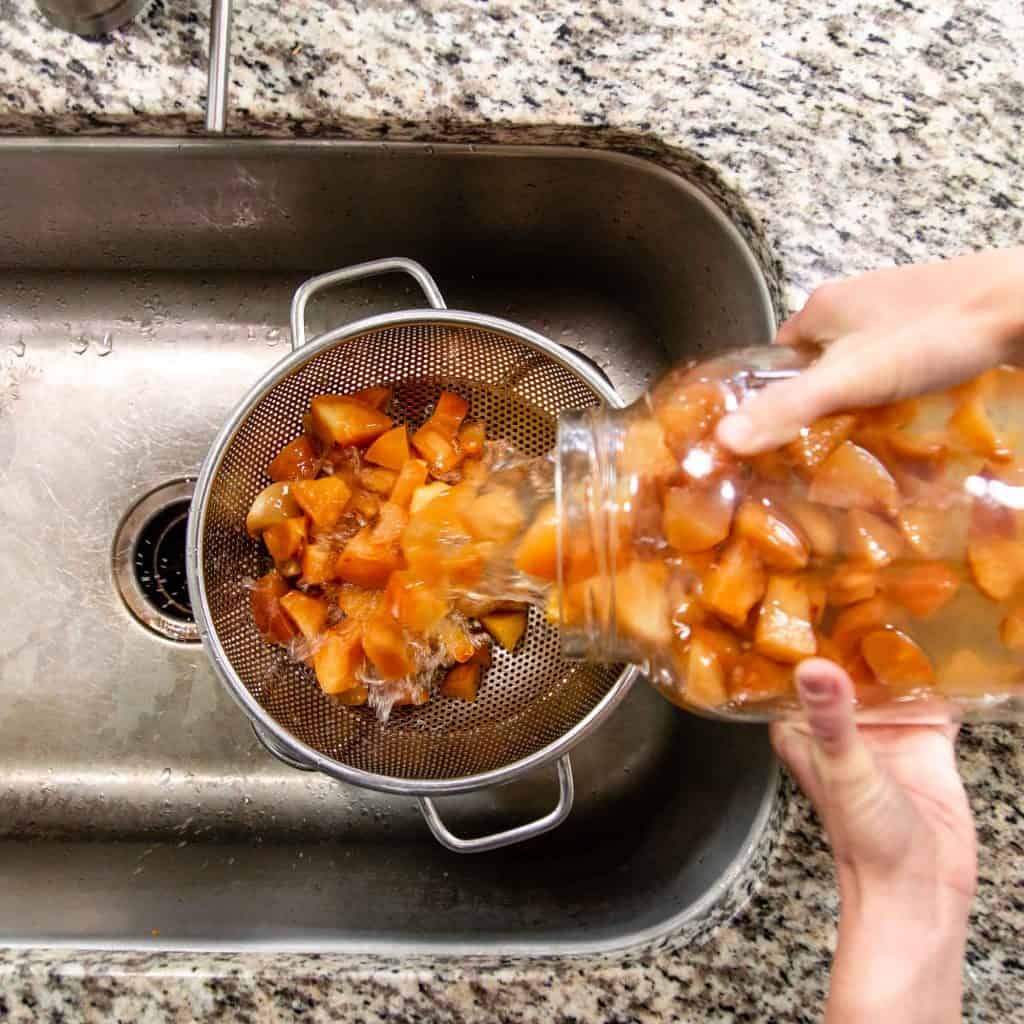
How to Make Apple Cider Vinegar
There is a slight difference between apple cider vinegar and apple scrap vinegar. The recipe in this blog post is more similar to an apple scrap vinegar, even though I use the whole fruit and not just scraps.
In order to make “true” apple cider vinegar, you need to first make apple cider, and then change that apple cider into vinegar.
Here’s my blog recipe for making apple cider at home. Once you make apple cider, you can turn it into vinegar by adding a vinegar mother and covering with a cloth lid. It should take about 4 to 6 weeks to turn the apple cider into vinegar.
I think my recipe (below) is easier and more functional for making vinegar at home. It’s definitely easier than going through the whole process of making cider first.
It is slightly less acidic than apple cider vinegar, but still delicious. Plus, this method is applicable to many types of fruit or mixes of fruits.
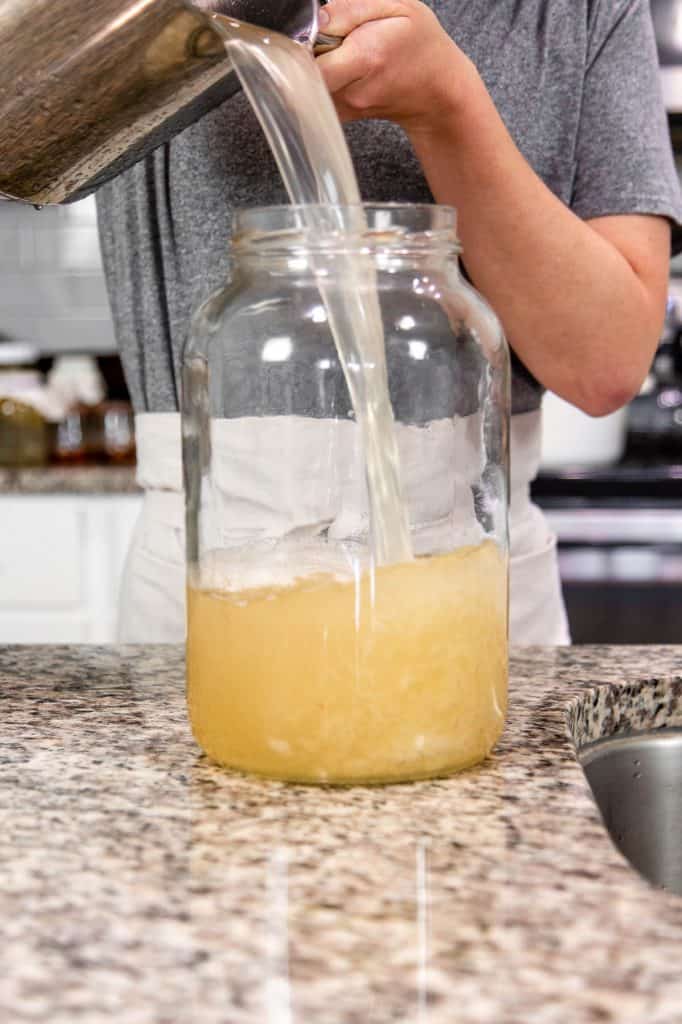
What is a Homemade Vinegar Mother?
Vinegar “with the mother” is another name for raw vinegar containing all the microbes from the brewing process. So, think of the mother as microbial cultures. Vinegar mothers form cloudy floating pieces within the vinegar and a SCOBY on the surface.
A vinegar mother SCOBY looks similar to a kombucha SCOBY but is often lighter with varying textures. Vinegar mothers in homemade vinegar are always unique. No two will look exactly the same because the wild microbes from fruit scraps will be slightly different across batches.
You can use the vinegar mother SCOBY from your first batch of vinegar to culture the next batch of vinegar.
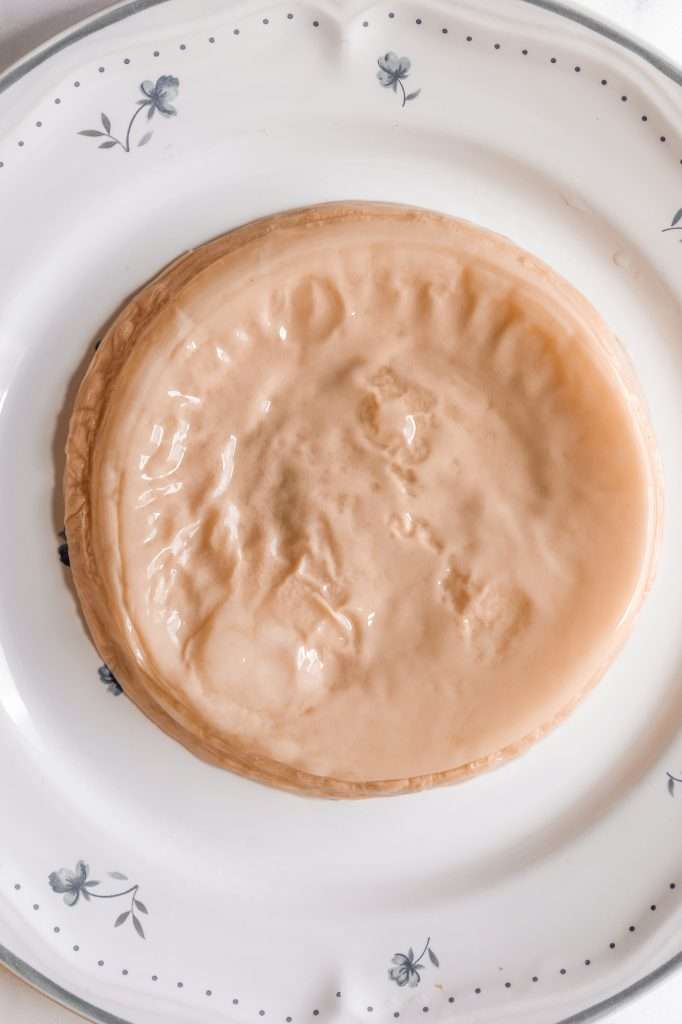
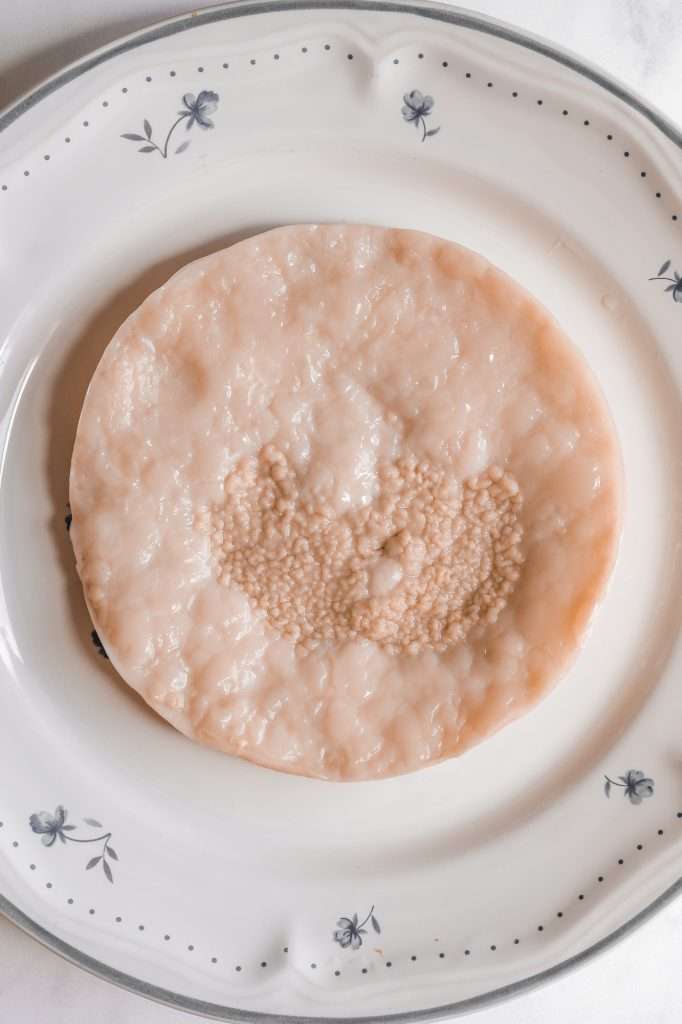
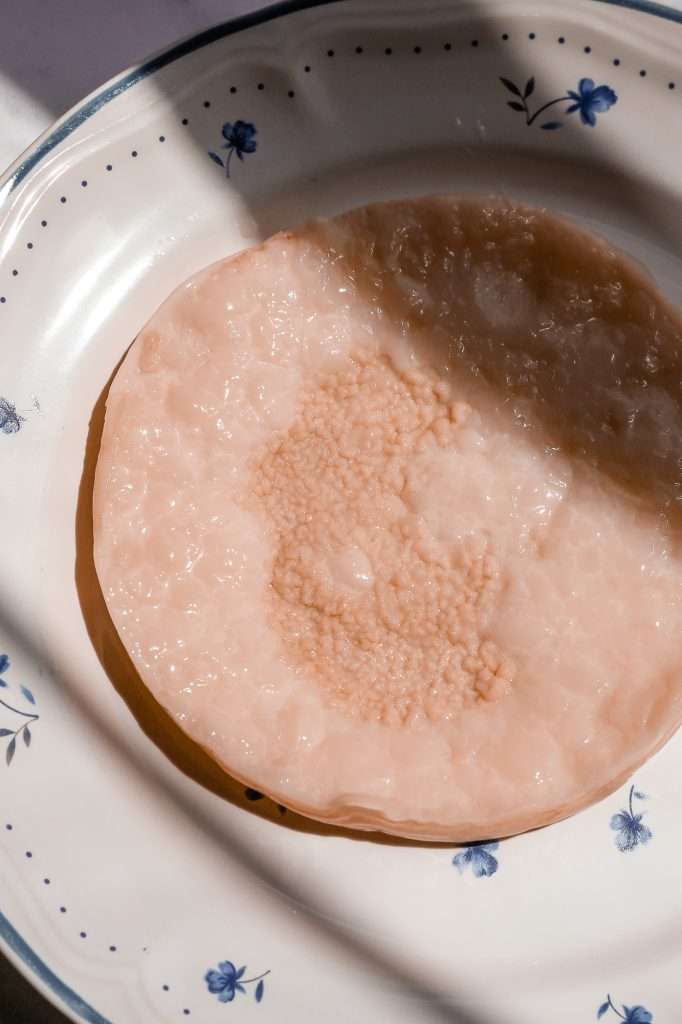
Homemade Apple Cider Vinegar
I still call the vinegar I make using this recipe “apple cider vinegar” when I make it with apples. It tastes almost exactly like the ACV I buy at trader Joe’s, and I bottle it in recycled apple cider vinegar bottles from the store.
The keys to remember when making ACV or any fruit vinegar at home:
- Stir the vinegar once daily. Remove the cloth lid, give it a good stir, replace the lid and repeat daily until you strain the vinegar.
- You must use a breathable cloth lid. The microbes involved in vinegar production require oxygen to convert alcohol to acetic acid.
- Use a clean glass container. It is best to use glass when fermenting acidic vinegar. Clean your equipment well before getting started.
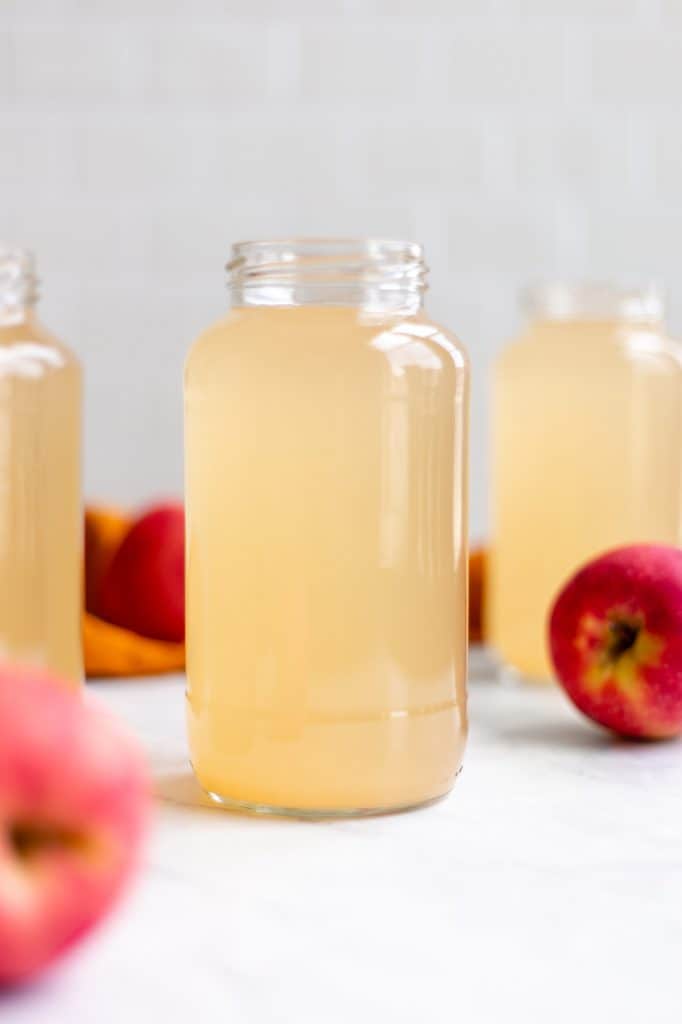
What do you use fruit vinegar for?
I use my homemade fruit vinegar in any recipe where I would use store-bought vinegar. Since fruit varies in sugar content depending on ripeness, the acidity of each person’s vinegar will vary a bit depending on the fruit used.
It may or may not be adequate for pickling and canning pickles. To make a strongly acidic vinegar, you can use more sugar and use fruits high in fructose, like mangoes. You can also add in some sulfite-free wine, tequila, or vodka in place of some of the water.
You can also test the pH with a pH strip to see if it is good for pickling/canning. Vinegar that is safe to use in pickling recipes should be approximately 2.4 pH (about 5% acidity).
Here are my favorite ways to use homemade vinegar:
- for homemade salad dressing
- with homemade bone broth
- in heirloom culturing recipes like this fermented cherry tomatoes recipe
- in mineral-rich hydrating drinks (I like to mix a tablespoon of fruit vinegar into a quart of water with a splash of coconut water, orange juice and a pinch of sea salt for a homemade hydrating “gatorade”)
- I love using my fruit vinegar to make Fermented Pickle de Gallo.
- You can also use homemade vinegar in Oxymel and Fire Cider recipes.
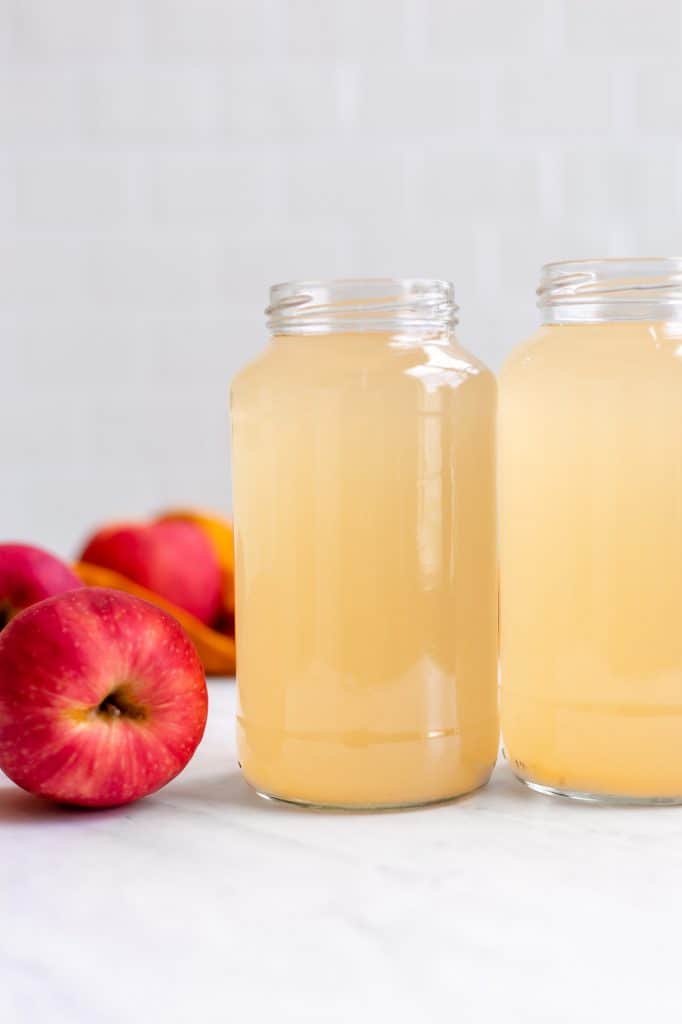
Things You May Need:
Print
How to Make Vinegar from Scratch
My easy fermented fruit vinegar recipe requires only four ingredients: fruit, sugar, water and starter. This is the perfect recipe to use up fruit scraps and overripe fruit. You can use this recipe to make homemade apple cider vinegar, apple scrap vinegar, berry vinegar, and more!
- Prep: 10 minutes
- Total Time: 1512 hours 10 minutes
Ingredients
- 6 cups of fruit*
- 255 grams of organic cane sugar
- Water
- 3 tablespoons raw apple cider vinegar with the mother (as starter culture)
- 1 gallon glass jar
- tight-weave cloth covering
- rubber band
Instructions
- Please read the recipe notes.
- Chop the fruit into small chunks.
- Add the sugar and apples (or other fruit) to a 1-gallon glass jar.
- Add water to the jar until full.
- Add in a few tablespoons of raw apple cider vinegar with the mother. This helps establish a good microbial community, and while it isn’t absolutely necessary to add I highly recommend it. If you’ve made vinegar before and have a vinegar mother, you can add it.
- Stir the mixture until all the sugar is dissolved.
- Place a cloth lid (tight-weave is best, like t-shirt material) on the jar and secure with a rubber band.
- Stir the mixture once or twice a day and allow to ferment at room temperature for three weeks. Don’t forget to stir it. I like to just do it first thing in the morning each day.
- You should notice the mixture bubble within one week.
- After three weeks of fermentation, strain out all the fruit pieces, replace the cloth lid and allow the mixture to ferment for 6 more weeks.
- You will notice a vinegar mother form on the surface (it looks like a kombucha SCOBY but is very light in color). You can keep this to start your next batch of fruit vinegar.
- After fermentation, bottle the vinegar and seal it with a solid lid. Store at room temperature in your pantry.
Notes
- you can use any of your favorite fruits in this recipe. High fructose and fructan fruits tend to make the best vinegar. See a list of my favorite fruits above the recipe card. Use organic and homegrown fruit whenever possible. Conventional fruits sprayed with pesticides may not work well and may lead to kahm yeast.
- Vinegar works best with a starter culture. While it is possible to make vinegar without it, adding a vinegar mother or raw apple cider vinegar with the mother to the mixture ensures success. If you have a kombucha SCOBY or raw kombucha, you can sub for that with good results.
- For very strong vinegar, you can also add in some sulfite-free wine, tequila, or vodka in place of some of the water.




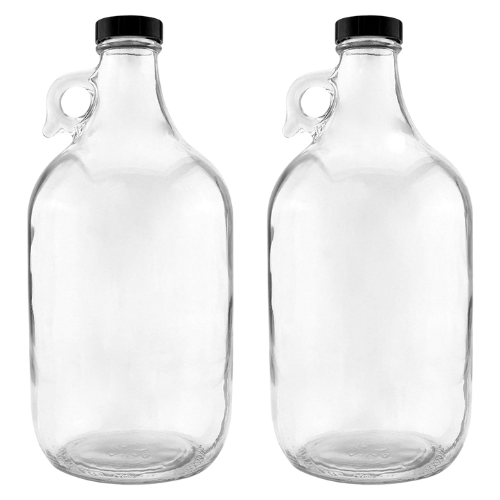

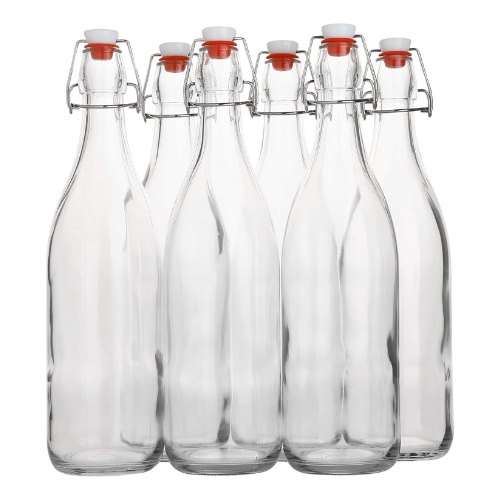


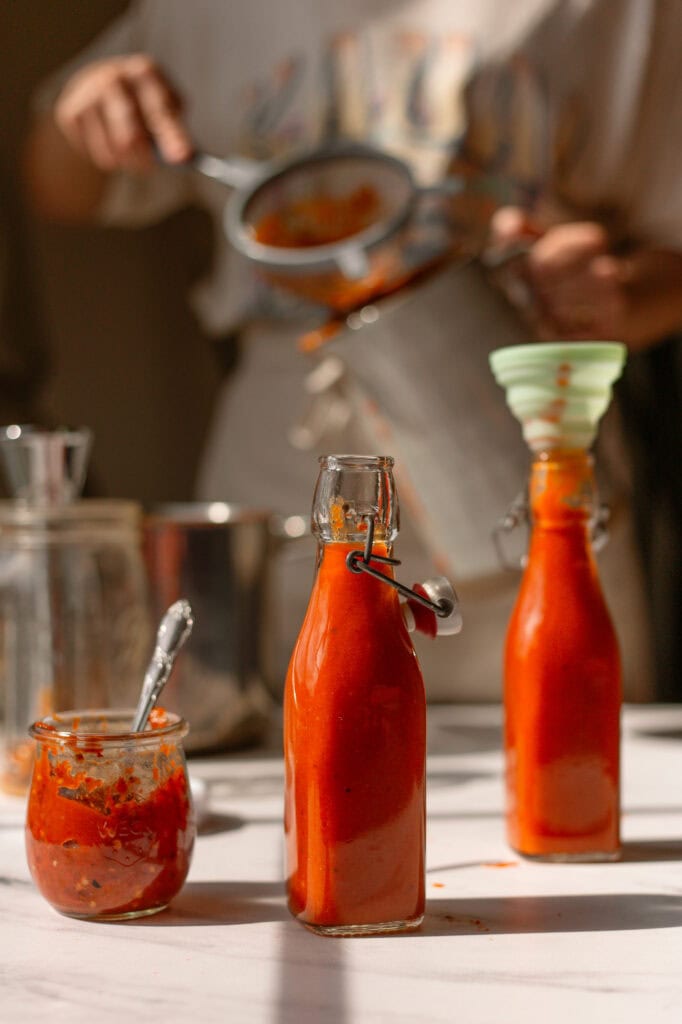





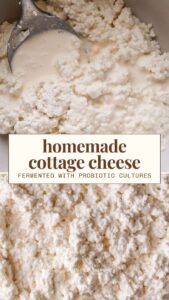

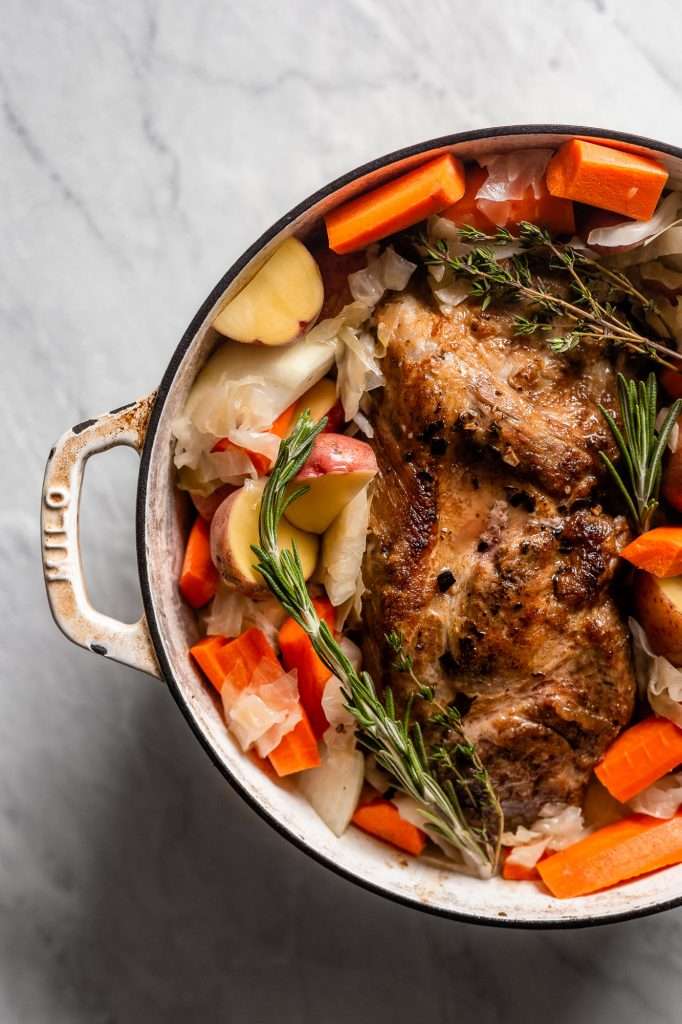
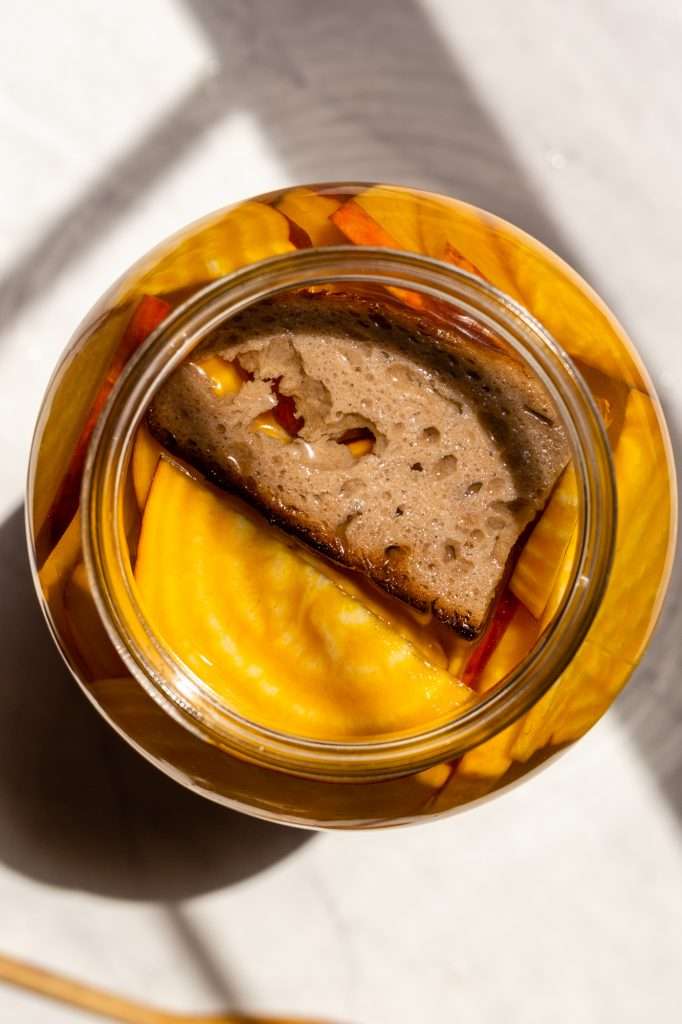
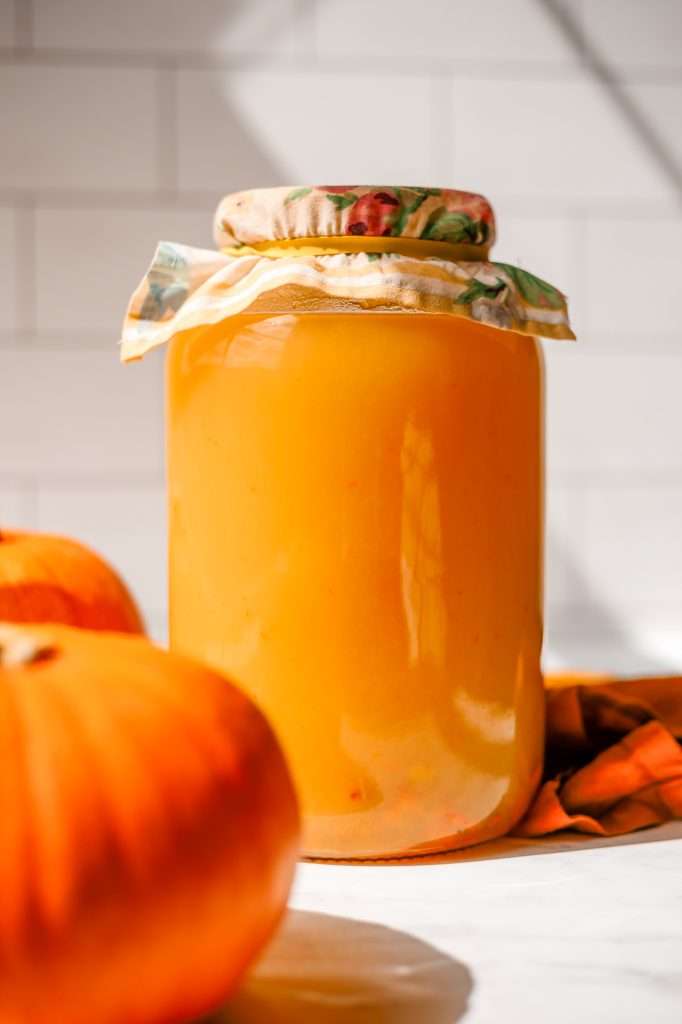

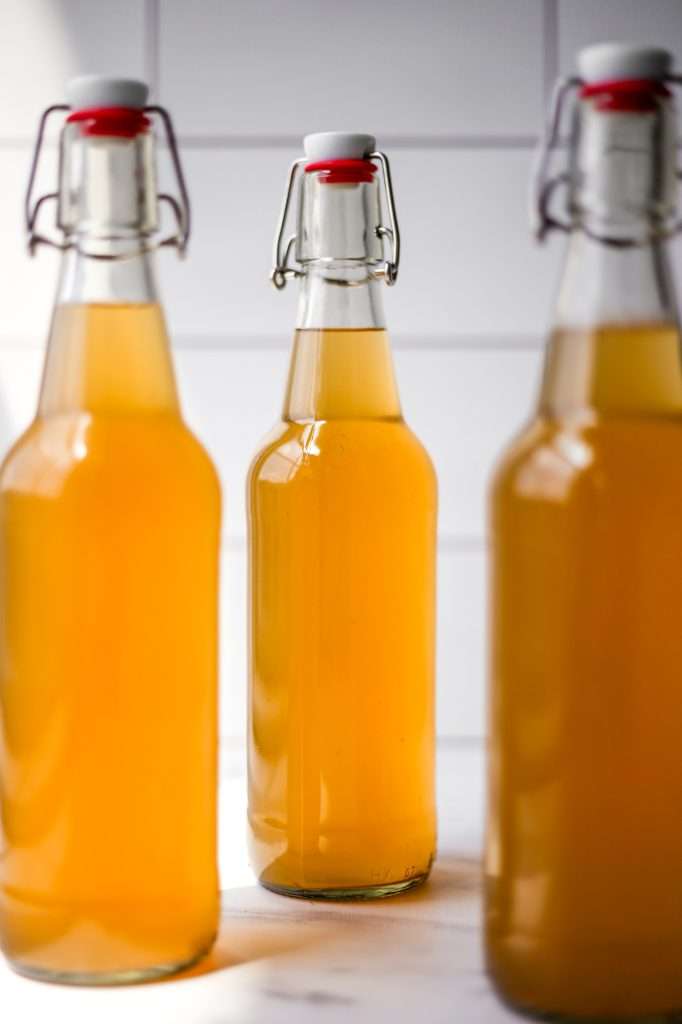


Hi Kaitlynn,
In terms of cleaning equipment and ingredients, I have two questions:
1. How do you sterilize big jar for making sauerkraut ? ( I usually rinse it with boiling water, rinse it again with cold water, rinse third time with medical alcohol 70°C and scrub it with clean towel )
2. Should I boil the water and let it cool down before making Sauerkraut?
Thank you Kaitlynn! Truly grateful to find your unique among most of misleading and unscientific posts on the Internet! ( Recently, I just commented on your post of Water Kefir 🙂 )
Fantastic well explained recipe thank you. Can I use this for making things like homemade dill pickles or isn’t it acidic enough? If not can I make a more acidic one as would like to do the whole process myself
Since fruit varies in sugar content depending on ripeness, the acidity of each person’s vinegar will vary a bit depending on the fruit used. It may or may not be adequate for canning pickles. To make a strongly acidic vinegar you can use more sugar, and use fruits high in fructose, like mangoes. You can also test the pH with a pH strip to see if it is good for pickling. Vinegar that is safe to use in pickling recipes should be approximately 2.4 pH (about 5% acidity).
Started my journey on learning all about fermentation. You explain clearly without waffling. Thank you
Hi Kaitlyn! For step 9, do you continue to stir once daily throughout the next 6 weeks of fermentation? Thanks for sharing!
Hi there! Once the fruit is strained off, you no longer have to stir it daily.
Hi, l have tried to make vinegar a few times now and everything seems fine until I get to the second fermentation. The vinegar starts evaporating until there is nothing left well before the 6 weeks is up. I keep it in a cupboard that is not particularly hot so I am at a loss as to what is happening.
it evaporates that much?? wow. Where do you live and is it an arid climate? I’m so curious because I’ve never considered this with vinegar since its about 50% humidity where I am.
Hello!
thank you for the recipe! 🙂
In turkey we usually stir it until all the fruit sinks (app 3 weeks) then we let it sit with the fruit for another 4-6 weeks than strain and again let it sit for 1 week then add a little bit of salt and bottle it.
I was wondering what is the difference between these two different recipes..thank you <3
Either method is fine and results in good vinegar. I’ve made it before as you describe, leaving the fruit in after it sinks and it came out great. I don’t add salt to vinegar, but you can if you want.
Miss Kaitlyn,
When the sealed bottle of vinegar is stored at room temperature, will it not continue to ferment if not sterilized?
Thank you.
The microbes in vinegar fermentation are aerobic (they require oxygen to ferment). So when you put the vinegar in a sealed bottle with a solid lid, fermentation halts.
Ms Kaitlynn,
Thank you so much for your reply. So that’s why when I left my finished pineapple and dark beer vinegars in their jars with breathable covers (as advised by an online source) they developed multiple “scobys” and eventually got molds and putrid smells and had to be discarded. I am now encouraged to try and make vinegar again. Many thanks.
Ms Kaitlynn,
Re my previous comment, I meant pasteurized, not sterilized! So sorry.
Is there any way to do this without sugar as I am not allowed to have sugar
No, sugar is necessary to the process.
Hi Kaitlynn. I’ve made vinagre with apples a couple of times with results improving every time. But in my last batch I completely forgot to add the sugar, and was tempted to discard it, but then decided not to. So in week 2 I added sugar just in case, like 3 spoonfuls, and let it sit and continued the process. When the time came to finish the process I had no faith in it and It came out the best vinegar ever! I doubt I’ll ever get one as good as that one!
Cheers from Santiago, Chile.
Could you use maple syrup instead or honey? As I understand it the microbes need to eat. Once the fermentation is done is there still sugar or other sweetener in the vinegar?
you can! Honey has more FODMAPs so it works better, but maple syrup will also work.
Hello, wondering if you could help me trouble shoot something? I made up a gallon of this and forgot to stir for a few days. Just took the cloth cover off to stir and there is mold growing at the top of the jar. I’m assuming it’s no longer safe to use? Would that have happened because I forgot to stir or is it from another cause? Just want to confirm before I start the whole process again! Thanks so much!!
The mold definitely grew because you did not stir it. It is no longer safe. The stirring is not optional, It prevents mold and it introduces oxygen to the mix so that acetic acid bacteria can grow and form a vinegar mother.
Thank you for your response! That’s what I figured but I’m glad to know for sure before giving it another go. I’ll set a daily alarm this time around. 😉
To store this, can I just put a screw top lid on the jar? Is that sufficient for “sealing” it?
yes!
Just started a batch! Crossing my fingers it will work for me. I used the scraps from making apple butter—so peels and cores from 6lbs of apples! My question is when you say “bottle and seal with a solid lid” do you mean like can it with a hot water bath canner so the lids seal like I do with jam?
No, I just mean bottle it and close the bottle with a solid lid fit to the bottle.
When we made vinegar, the cloth covering was not tied on well and gnats got into the vinegar. Will this contaminate the vinegar?
It can. If it was a fruit fly, they can lay eggs in the jar…
Thanks so much for the great content. I’m eager to try this, along with several of your other recipes. About the sugar – I try to avoid refined sugar as much as possible. Is the sugar “eaten” during the process? Can you use honey instead? Will it change the taste? If so, do you recommend the same quantity as the refined sugar?
The sugar is all used up in vinegar production. The microbes turn all the sugar into alcohol and then the alcohol into acetic acid (vinegar). You can use honey! It works great. You should use the same amount.
Hello Kaitlynn,
I’d like to use pumpkin scraps to make pumpkin vinegar. Will this work as with other ingredients?
Thank you
Yes, pumpkin should work fine in this recipe!
Un consulta, despues de este paso “Después de tres semanas de fermentación, cuele todas las piezas de fruta, vuelva a colocar la tapa de tela y deje que la mezcla fermente durante 6 semanas más.” Se cuela la fruta y que se hace con el liquido y la fruta?? Te quedas con el liquido y tiras la fruta???
You strain the fruit out of the liquid, and you keep fermenting the liquid in the same jar… the liquid is the vinegar.
I used your recipe to make apple cider and now want to use some to make vinegar. I’m thinking I won’t have to stir it everyday. Please advise. Thanks, Rebekah
If there are not fruit pieces in it, you should not have to stir it. Add some raw vinegar as a starter, put a cloth lid on and let it ferment.
How do you store your Mother for next time? Fridge?
I store mine in a closed jar at room temperature with some of the vinegar.
Can the vinegar mother be used as the scoby for a batch of kombucha? Also, when stored in vinegar at room temp, how long will it remain usable? Thanks!
Hello, thanks for this info. I actually followed a recipe I found on YouTube, but have since grown a vinegar scoby and my original recipe didn’t advise about this, so I’ve scoured the web to find more info on this. Now I have it, how do I use it to start off new batches? Surely the fruit and the scoby bump up against one another?
Thanks in advance x
You can add the vinegar mother in at the beginning or after you strain the fruit out.
Thanks for all your work and great information, got some apples and I am definitely going to try this!
May I just clarify, do you include seeds when you say scraps? Or better to leave them out?
Also, just out of curiosity, why do you instruct that we use fruit by cup and not by weight? (Like I’ve seen in your other recipes) just not as critical for this?
Thanks in advance.
Hi there!
It’s okay if you include the apple seeds. And correct, the exact amount of fruit is not as critical for this kind of vinegar recipe.
Hey Kaitlynn just wanted to come back and Thank you again. I ended up leaving it in the larger jars up until now but finally got around to bottling it. Heaps of mother and a beautiful and strong scent to it. Look forward to trying this again. I’d post some photos of it here if I could, such a rich colour!
Can you only use 1 fruit type at a time or use a mixture of different fruits?
You can mix!
Hi! I’m new to this. After this is completed and stored, how long is the vinegar good for? Thank you!
It should be good for a very long time! At least over a year.
Question 1.) My strawberry kiwi vinegar from your recipe (in a large glass jar) seems to be a thick creamy color throughout. We are stirring as we should be. Should vinegar be creamy in color or closer to clear? It all seems fine otherwise.
Question 2.) I am making a vinegar from tangerine and lemon fruit scraps per your directions. I stir twice daily. Each day seems to form a white looking growth on top along with lots of bubbles that is accompanied by some of the mostly small lemon pieces that have worked loose from the lemon pieces. If I listen closely, I can sometimes hear the bubbling. I can stir the daily white formation in. Is this white formation on top normal? The citrus vinegar looks different than my strawberry and my apple vinegar jars. It is nice and bubbly. Is it normal for citrus fruit vinegars to look different in appearance on top? My citrus vinegars are the only ones that have a white daily growth on the top.
Question 3.) Are homemade vinegars suitable to use as cleaning vinegars?
So glad I found your site. I LOVE it! Thanks for sharing your knowledge and helping others.
Hello!
1. All vinegar will become quite cloudy and murky while it ferments. The cloudiness is microbes growing.
2. It sounds like you are seeing yeast grow on the surface. If it’s chalky and powdery white, it’s probably kahm yeast. Are you using citrus peels in it? that could be an issue.
3. You can use them to clean! They just might not be suitable for canning and pickling because the % acidity is variable.
Did the apple cider vinegar from scratch recipe. Was very straight forward and easy to make. The scratch vinegar is excellent taste. Use it on fries and way better than any cider vinegar i’ve bought from a store. How do I keep the mother of vinegar that was created for later batches?
Happy you enjoyed the recipe! I keep my vinegar mother in a mason jar with a little vinegar in the fridge.
Hello Kaitlynn,
I am trying to troubleshoot a vinegar ferment that I seeded with a vinegar mother from a previous successful batch. I added blackberries, no sugar, distilled water, some white wine, and my mother to a sterilized quart jar, then topped with a paper towel with rubber band. Its been around five days. Now I have a quarter inch of white growth on top that doesn’t look rubbery like the original mother, more wrinkly like an old person’s skin. It isn’t fuzzy on the top. From the side view (through the jar) it looks like flaky snow underneath where it borders the water. I haven’t been stirring the vinegar because I was afraid to disturb the original mother. Do you think I have a second mother growing or mold?
Hi! Sounds like kahm yeast. Blackberries are a high-sorbitol fruit; in fact, the only fermentable sugar in blackberries is sorbitol. This usually leads to kahm yeast contamination because the wild yeast thrive on sorbitol. Also, white wine usually contains a lot of sulfites (unless you used a certified sulfite-free wine). Sulfites are added to wine to stop acetic acid bacteria from turning alcohol into vinegar. So if there are sulfites in your mixture, it will cause major issues.
After the three weeks did i need to keep stirring daily, or nothing at all?
After you strain it, you no longer have to stir it.
My last batch of vinegar developed multiple scobys and eventually made this large stringy mass that floated in the vinegar. I’m assuming this was the ‘mother’. Question 1.) Is it okay to strain this out of the vinegar? Texturally it is a little…off-putting. Question 2.) Aside from mold, is there a way to determine whether the vinegar is no good?
Thanks for sharing your awesome knowledge! I just strained out the fruit from a batch of pineapple vinegar and am looking forward to seeing how that tastes after a couple more weeks of fermentation. Also, one more question – I live in Texas and my average house temp is around 77 degrees. Can this accelerate the fermentation process with vinegar as well as sauerkraut? Thanks!
Hi there! You can strain the vinegar if you want. The stringy stuff is the mother. You can test the pH with a pH strip to make sure it’s a good acidity. 77 is an average temp and it won’t speed up fermentation much.
Can I eat the apples or do I have to throw them away?
This looks great and I would love to try. I just have a question about the apple cider vinegar with mother addition. Do you just add the 3 TBs of the vinegar that has mother in it or do you actually try to scoop out some of the mother from the jug? If so, how much? Of the mother is needed? All of it? Some of it? Am I getting 3 TBs of just mother? From the jugs I’ve gotten in the past I can see it floating around but not that much I don’t believe. And moving forward if I have my own mother from making this recipe how much would I need as well.
Thanks for your help and time.
It’s just three tablespoons of vinegar with the mother in it. You can shake up the vinegar before measuring it out. In the future, you can repeat this process with three tablespoons of your homemade raw vinegar with the mother. There will also be a mother that looks kind of like a kombucha scoby in your finished vinegar. You can keep the scoby mother in a jar of vinegar and put it in the new batch after you strain the fruit pieces out.
Awesome, thanks so much!
Hi Kaitlynn,
Thank you for this recipe. We made it with Granny Smith peelings and cores left over from something else, and the resulting vinegar is lovely. We are bottling today,
There was no scoby formed on top, although there is sediment on the bottom of the bottle.
I’m going to try strawberries next!
Warmest regards
Ron
Thank you so much for sharing your recipes and knowledge!
I have a very thin Scoby on my apple cider and today is bottling day.
The vinegar smell and taste us very faint, kind of just takes like very lightly sour apple juice. Does this sounds right?
Thank you 😊
I have just started a batch from previously canned muscadine juice. I followed the rest of the recipe with 2 gallons of juice. I have read about stirring until you “remove the fruit”. Since this is only juice do you recommend that I stir this daily for the first few weeks to help oxygenate and prevent mold from growing?
Oh, that sounds delicious! You should still stir it to oxygenate it, at least for the first few days.
Would blueberries be good for this? And if so, do they need to be sliced/crushed? Or just throw them in whole?
Blueberries work great! I’d crush them first.
Hello!
I am trying this for the first time and have a couple questions, I used apple scraps and grapes, I also used an organic unfiltered apple cider vinegar with the mother. I missed one day of stirring it, because I was gone and forgot to have someone else do it is that okay? Since then it now has a white film on the top of it and up the little bit of jar sides to the top and all the fruit is sunk to the bottom and dissolving, is this normal? The white layer on top reforms every day and is kind of stringy looking and has little stringy lines all over it. I started this on 8/19 and I am supposed to remove the fruit on 9/9 but again it’s all dissolving so how would I go about removing it since it is becoming a mush?
Thank you so much! I really appreciate this whole website and all the information you share!!
Missing one day of stirring should be okay. Just keep stirring it and following the directions. When it is time to strain it, strain it through a fine mesh strainer or a colander lined with a few layers of cheesecloth.
Hello ,
Thank you for the recipe .. i strained the apples on 24 of august , covered the jar with cloth and secured it with rubber band .. now i can see white material floating and other in the bottom .. is it ready ? Or i shall wait until 6 weeks are over ? And whats the difference between this and the apple cider vinegar ?
Thank u
I suggest waiting the full six weeks. Just keep following the recipe.
Kaitlynn,
I’ve recently started my first batches of vinegar using your recipe and instructions. However, I’ve run into a problem I haven’t been able to find more information on. I’m hoping you can help.
One of my jars started out really well. It was bubbling very healthily and nice and active after about 5 days. It’s been about 3 days since then, and almost all activity has stopped in that jar. The liquid inside has also…Thickened, a bit? It’s not quite like mucous, but almost more like a syrup. The bubbles, when they were there, were also more like a foam as opposed to just ‘air’ bubbles that I’m seeing in my other jar. The ‘problem’ jar also is beginning to smell faintly alcoholic. The liquid inside is also cloudy, but I’ve heard this is normal for this stage?
Did it just ferment super fast? Has it ‘died’? This is my first time fermenting vinegar so I really am unsure of what’s going on with it.
Half recipe used
Fruit: Cantaloupe
Sugar: Organic Raw Sugar
Vinegar with mother used: Bragg Organic Raw ACV
Water Used: Distilled
The still active jar used all the same ingredients except made with peaches, not melon.
Thank you so much
This is all perfectly normal! and expected. Some vinegar will thicken in the beginning from the microbes fermenting sugars. It should thin out with time. Alcohol smell is normal because vinegar is made by allowing microbes to turn sugar into alcohol then alcohol into acetic acid. Just keep it going, it sounds like you’re on the right track.
Hi Kaitlynn, I’m very new to fermenting and there are so many confusion websites out there. I’m so glad I came across yours. I have a simple question, and it may be silly, but rather than cover my jar with a cloth, I’ve seen may post that use coffee filters. Does this give the vinegar enough air to ferment?
A coffee filter secured with a rubber band will work great!
If you forget to stir for 3 to 4 days should you throw it away
if it doesn’t have mold and doesn’t smell gross, it’s fine.
Hello, Kaitlynn.
Very good article.
You mention using cider yeast for very strong vinegar. Can this be accomplished using regular baking yeast?
I started a jar of apple vinegar 4 weeks ago, using this article, to which I added 1 tsp of active baking yeast. I’m about to start a new batch, using a melon, and I want to make sure that I haven’t made a serious error with yeast.
Thanks,
Joe
I haven’t tried that kind of yeast but it should be fine. You should have added some raw vinegar with the mother along with that.
Thanks.
I did add the vinegar. I’ll let you know in about 3 weeks, how it turned out.
I also HAVE to try your fire cider recipe, just because of the great photography.
Joe
The apple vinegar turned out very nicely. As I mentioned, I added 1 tsp of rapid rise baking yeast.
I bought some alkalinity test strips, and tested both my vinegar, and Bragg’s. The Bragg’s seemed to be a bit more acid, but the strips are pretty subjective/inaccurate, especially for a guy who routinely wears a grey shirt and black pants, because he never really “got” color combinations.
Many thanks for your instructions.
Joe
So, I followed your recipe with apples and strawberries. The first three weeks went fine, I even used a small mother from another batch to start it. It fizzed up. At about week 4 in the second fermentation, I tasted it and it tastes like water! After more research I learned that it needs to be sealed off from air as soon as it’s done or the lactobacteria start consuming the alcohol until there is only water left. What went wrong? It seems like my batch just finished way earlier than you suggested, but how can I tell when it needs to be sealed from air? Thanks for your help.
not sure where you are getting your info from but this is incorrect. Vinegar fermentation requires oxygen. Please see the body of this blog post for more information.
Thank you for your response. Yes, the production of acetic acid is an aerobic process, but once it is complete it seems the vinegar needs to be sealed. I found that info from many different sources. For instance, from Revolultion Fermentation it says, “Why does my vinegar taste like water? When vinegar is left to ferment too long, the bacteria no longer have any alcohol to consume. So, they turn to the acids they have just created. Vinegar left too long in contact with oxygen will oxidize excessively and lose its acidity. To prevent this from happening, transfer the vinegar to airtight bottles to avoid contact with oxygen.” I am just trying to figure out when my vinegar is done so I can seal it off. Perhaps at a certain pH?Thanks.
I’ve never seen this happen and I’ve left my vinegars to ferment on the counter for a LONG time. The timeline I recommend is the one in this recipe. It works for me every single time and I’ve made a ton of vinegar with many kinds of fruit. The only reason I’m aware of that vinegar would taste watery is if not enough alcohol is produced, so then not enough acetic acid is produced. Did you follow this recipe exactly or did you maybe reduce the sugar?
Hey Kaitlynn, thank you so much for all of your amazing recipes!
I am wondering if you can halve or quarter this recipe? I only have smaller jars so will need to get a large one to make the full recipe.
yes! You can cut it in half of in 4ths. It would great as 1/4 in a quart jar.
Thank you so much! 🙂 So excited to make it!
Hi Kaitlin, I was so excited to try your recipe for vinegar. I used defrosted citrus fruits and peels (mostly peels) in my version and followed the full volume recipe with sugar, water and quality ACV addition. It was crazy active in the beginning, calming as the process went on. Since straining it (+4 days) it now has a lot of white sediment at the bottom (i used a metal sieve to strain) and it also has a white layer on top which is veiny, almost like the start of frost on a window. From the side of the jar this layer looks about 2mm thick. The smell is similar to what I imagine a fruit scented nail varnish remover would be. I tasted it before the fruit removal and it was fine.
A) do you think this batch is ok/ will survive?
B) if it is ok do I include sediment when I pour off or not?
C) have you ever tried a batch with unripe tomatoes?
It sounds like the batch is perfect. Sediment is normal, that’s spent microbes. The layer you’re seeing on the top is probably a vinegar mother forming! The acetone (nail varnish) smell is also normal and expected. That smell happens when acetic acid bacteria begin to transform alcohol into acid. You should notice that smell go away and more vinegar smells to develop. I’ve only used ripe tomatoes, and it worked great.
Thank you. I was about to throw it away but I shall let it sit and do it’s business for now and hopefully have a successful batch. It’s very exciting!
The way you respond to commenters is fab, it’s really helpful for readers to see all the questions and responses too!
I forgot to ask, when I decant it to my final storage bottles, should I include the sediment or not?
Either way is fine! You can pour it off leaving the sediment behind, or mix it up and include it.
Kaitlin – I think you are amazing how you answer everyones questions – my first apple cider vinegar bottled today is brilliant BUT I made some cider vinegar afterwards and added the same amount of sugar – I sieved it today and it is very gloopy – I added another litre of water and I am wondering if I can expect the gloominess to go away?? THANK YOU
hi there! Yes, the gloopiness will go away with time, just let it ferment with the cloth lid on the counter for longer and it will thin out.
Hello, I made this with some Concord grapes from and it came out well… I’m ready to bottle but how can I preserve the SCOBY? Mine is a thick layer. Can I freeze it out will that lil the microbes? I’m not ready to make another batch yet.
Just place the scoby in a small jar with some of the vinegar covering it, put a lid on it and store it at room temperature
Thank you for all the great information! I’m looking forward to trying another fruit. I started a batch with apples last week. I’m curious if lemons would work? In my head it sounds like it would be delicious & super healthy, lol. Or atleast great for cleaning. What do you think?
Thanks again
I’m not sure about lemons because I’ve never tried it. They don’t have much sugar and I’m not sure what would happen with the added citric acid, especially if you include peels.
I tried this a couple of months back, using organic Eureka lemons, peels and all. I used a YouTube video for instructons, which were very similar to Kaitlynn’s. After several weeks of stirring, the pulp basically turned to mush, and looked seriosly unappetizing. I gave up at that point, and composted the whole batch.
It’s possible that I was too impatient, but at the time, the concoction didn’t look anything like the video.
Next time I have too many lemons, I’ll make preserved lemons, and give them away to people who like to make Moroccan dishes.
Joe
Hi, I appreciate your simple instructions and recipe without all the scientific stuff. I just have one question. You give the measurements in cups but the sugar in grams. How many cups is 255 grams of sugar. Thank you
Yeah the sugar is en exact measurement to help create a good acidity. Cups of fruit is a flexible measurement and introduces variability because all fruits are various levels of ripeness with various amounts of sugar. Google can convert grams to cups for you if you want to convert.
Above it says-
“To make a strongly acidic vinegar, you can use more sugar”
How much more sugar would you recommend to get the ph to 2.4?
Also,
Just strained mine and now it will set for another 6 weeks. If it does form a mother, next time to use it do I set it on the top of the apple/sugar/water mixture in the jar at the start? Thanks!
You can increase the sugar by 50 grams and that should do the trick. and yes, just add the mother to the next batch at the start or after you strain it, either way works. It will probably sink to the bottom, but it will still work.
It never formed a mother, does it eventually if I leave it longer than 6 weeks?
Thanks!
it should! if it doesn’t form one but still smells and tastes like vinegar, its fine.
Merry Christmas!!! Thank you very much for sharing this vinegar recipe. Now i made grape vinegar today, hopefully it will be a success…
Hi, I have a couple questions: should the vinegar continue to bubble after straining the fruit out? And how long does it take for the mother to start to form? I strained mine about a week ago and it doesn’t look like anything is happening so I’m not sure if it’s still fermenting. Thanks for the recipe!
No, vinegar does not bubble after straining, and you wont see much visible activity.
Hi, can I use this as cleaning vinegar as well? Thank you.
I don’t recommend cleaning with it. It’s stickier than distilled white vinegar.
On week 8 of making Apple vinegar using scraps and there is no scoby. Is this normal or did something go wrong?
It’s normal. Sometimes a SCOBY won’t form, or it will take a long while when it’s cold. If it smells like vinegar and tastes acidic, it’s good to go.
Can I ferment fruit/fruit scraps with leftover wine that has been un-sulfured and skip the first fermentation step?
yes! you can do it like in this recipe! White Wine Strawberry Vinegar Made with Strawberry Tops
Thank you so much for sharing your knowledge and experience! Mine hasn’t grown a scoby, did I do something incorrectly?
Nope! Sometimes it takes a long while for a scoby to form, and sometimes they don’t form.
Thank you for a great explanation Kaitlynn! Can you tell us the percentage ratio of water – sugar – fruit? I intend to make small different sized batches.
Thank you so much for this recipe! I am halfway through the second six weeks, and I had a beautiful pellicle forming on the top. I noticed today though after checking on it, that the pellicle had sunk to the bottom and a new one seemed to be forming on top — My jar is stored on the ground in a corner and I picked it up to check on it and I’m thinking I jostled it? Should this be a problem?
Also, when I make a second batch and use the mother SCOBY in it, do you add that into the jar in the first phase with all the fruit scraps or just place it on the top after straining?
Thank you!
Glad you enjoyed the recipe! The pellicle sinking to the bottom is totally normal. Mine sinks to the bottom all the time, and it’s not a problem. When I use the mother SCOBY to make another batch, I put it in during the first phase and it usually sinks to the bottom. When I strain it, I pick it out of the fruit scraps and put it in the strained liquid too.
Thanks
Can I use raw honey from my beehives instead of cane sugar?? Love your content, thanks so much!
yes! Honey will work great.
My fig vinegar has attracted many fruit flies. I have a doubled up piece of cheesecloth on it since day one. Am I doing something wrong, and what can I do to minimize flies?
It needs to be a tight-weave cloth, like a cut square of cloth from an old T-shirt. The holes in cheesecloth are too big, so the flies can find their way through. Also make sure the cloth is tightly secured around the rim of the jar with a rubber band.
Hi there, I would love to try this with the abundance of peaches I’m getting from my garden. Peaches weren’t on your favorites list though so I’m wondering if they are too high in sorbitol. Thanks!
yes, they are. Sorbitol is the main ferment-able sugar in peaches. I would suggest making this peach cider. If you don’t drink, you can brew the cider then turn the cider to vinegar by adding some vinegar with the mother. Homemade Peach Cider Recipe with Honey (Peach Cyser)
Question: Can I use frozen fruit to make vinegar? I have a lot of homegrown strawberries which I froze. Can I use them?
yes, frozen fruit can work! Add a little extra raw vinegar as starter to ensure it starts fermenting.
Hi Kaitlynn! Thanks for responding to the comment about frozen fruit. Should we thaw it first or is it okay to put in still frozen and then add the extra vinegar as described? If we have a vinegar mother should we wait until the fruit has reached room temp in the mixture? Thank you!
A very encouraging description!
I’d like to make rhubarb vinegar. Should I do anything differently? I do not have access to a ‘mother’.
You shouldn’t need to do anything differently! I recommend using any raw vinegar you can find at the store as a “mother” because this recipe works best with vinegar starter culture
You know your stuff!!! My son is now involved in this journey, so we’re going the long way now. How do I (we) make ACV from homemade hard apple cider? Can I useBragg’s ACV with the mother to kickstart the process?
just put some heard cider in a jar, and add in some starter acv with the mother. Cover with a tight-weave cloth.
Hey! Today I finished my first ever batches of vinegar. I experimented with different fruits. I did three jars of pineapple, two jars of apple, 1 jar of peach, and 2 jars of cranberry. All the pineapple jars turned out just lovely! The apple… one of the jars turned out great, the other smelled… awful… so I dumped it. The peach turned out great! And I seem to have made some quite delicious cranberry juice. Just wondering what I might have done wrong with that one jar of apple that made it smell rank and why my cranberry jars, though developing a mother like the rest, just tastes like potent juice. Any thoughts or guidance would be appreciated. Also what to do with all these mothers now??
Hey! There are many things that could have gone amiss with that one jar of apple vinegar, and there’s no way for me to know since I can’t smell it or see it or test it. As for the cranberry vinegar, cranberry juice is the same acidity as store-bought vinegar, so your perception of the acidity isn’t going to change much as it turns to vinegar. If you see a healthy mother growing on the surface and it smells nice, then it sounds like you have cranberry vinegar
Hi there! I started this recipe today, but I accidentally put too much apple cider vinegar in the mixture. I put a 3 tablespoon amount in the half gallon jar. When I meant to half the apple cider vinegar. Should I rinse the strawberries and start over? Or will the extra vinegar just speed up the fermentation process or makes the end result more acidic?
It’s all fine! Don’t start over. The extra vinegar is great and won’t change anything, except maybe make it even better : )
Hey hey I bottled up a small batch of apple vinegar and there’s a bit of fizzy action happening. While I open a bottle I can hear it and see a stream of bubbles rise. What would the cause of this be? I did 3 weeks, strained, then 6 weeks before bottling.
It’s not done fermenting. Means there’s still some sugars in there. Sometimes it takes longer to make vinegar with higher sugar or super ripe fruits. You can pour it into a sanitized jar with a splash of some done vinegar with the mother and let it sit longer with a tight-weave cloth covering.
Hello,
I started my first batch 2 weeks ago and I don’t see any evidence of fermentation. Should I start over?
What “evidence” are you looking for? not much is going to happen with the smell in two weeks. the whole fermentation takes much longer.
Have you discarded the persimmon vinegar? You posted it on insta and I can‘t find it. aren‘t you happy with the result or have I just not found it yet? Thank you so much!
The persimmon vinegar I showed on Instagram was made using this recipe! You can use this recipe with basically any fruit. I just advise staying away from stone fruits (they’re prone to kahm yeast)
Just straining my first batch to give as Christmas gifts! Thank you for the easy to follow recipe!
I was reading comments about using frozen fruit, should we bring it to room temp first or is it okay going straight in with the water and sugar? Also if we add the mother (I noticed a lot of your responses say it’ll sink to the bottom) do we still stir the first 3 weeks? Thank you for your time and knowledge!
I followed all your directions and my vinegar did not make a scoby. What did I miss? Is it still usable? Should I let it sit longer? There is some stringy stuff, but not a scoby.
It doesn’t have to form a scoby on the surface to be a success! If you let it sit longer undisturbed, one will probably form. Might take longer if it’s cold in your home.
Hello! I made this recipe using apples. Believe I followed the recipe completely. From everything I have read of yours, it seems it all went to plan; measured exactly, never missed a day stirring, it all bubbled as you said it should. My vinegar did not form a scoby but I believe I read from your site not all will form one? Made it to the end of the six weeks a few days ago, finally gave it a taste test today…and it just tastes like a really sweet apple juice. Did I get something wrong? Does it need more time? I know you said vinegar like this often has a lower acidity but there is no vinegar taste at all. Thank you!!
it should not taste like sweet apple juice, it should be sour and tangy like vinegar. Did you add some raw vinegar with the mother as a starter culture?
Yes, I did. I used Bragg Apple Cider vinegar with the ‘mother’
Hi! Just found you and I am excited to try so many of your recipes!
However…on the fly, before finding you, I just threw some apples, unmeasured sugar and water into a fermentation jar w/ the ‘air trap/release’, weight and put it in my pantry. It’s been about 3 weeks. No stirring. I have a scoby that’s grown. Because I did this with very little knowledge my concern is whether or not it is safe. 😬 I’d hate to throw it out if not. Next time I’m using your instructions!
**Can I safely use what I’ve got?**
if you’re unsure about the vinegar you made, I suggest buying some pH strips and testing it to make sure it’s acidic. I can’t help much with recipes I haven’t tested myself.
This was very easy and my vinegar turned out great. It is very sweet, that makes it wonderful to drink a tablespoon or two, but does anyone know why mine turned out so sweet? I used apples I bought from the reduced produce section.
If it’s still sweet that means not all the sugar has gone through the two step conversion from sugar to alcohol to acid. The longer you let it ferment, the less sweet it will be. When it’s cold in the winter, fermentation can take much longer.
I have never made vinegar before, Would you please explain the starter as I have no idea how to make it .
Thank you
the starter for vinegar is raw vinegar. you can find raw vinegar at basically any grocery store. It’ll say “raw vinegar” and “with the mother” on the bottle. It’s the same concept as using store bought yogurt to culture milk to make yogurt.
Hello there! Thank you for sharing this. I am starting my vinegar journey and was wondering how do you tell the scoby from kahm yeast. Also, is kahm yeast harmful?
a scoby/mother is smooth and somewhat shiny, kahm yeast is crinkly and looks like chalk.
Very good 👍👍😊😊
Great to learn from an expert. Thankyou so much.
Hi Kaitlynn! Thank you so much for this recipe – I made a plum vinegar and a green grape vinegar that have both been really active so far! Unfortunately I did not use a large enough vessel and so there wasn’t a ton of liquid left after straining the fruit. What’s the best way for me to save it? Should I add more water and if so should I also add more sugar? Switch to a larger vessel and add the fruit back in along with more water (and would I need more sugar too)? Thank you!!
I’d say work with the liquid you have strained, just put it in a small jar. It can be your super special small batch vinegar. Don’t add water, that will dilute the acidity.
Then you can put all the same fruit you just strained in a larger jar with fresh sugar water, maybe some more fruits, and see how that does for a second batch.
I don’t have raw acv or mother of any sorts can I make the vinegar without a mother or raw acv?
It is possible to create vinegar without a starter culture (mother). However, I highly recommend picking up some raw vinegar with the mother or even some kombucha from the store to use as a starter culture for optimal results.
Hi Kaitlynn, I followed this recipe and its now 8 weeks. My mother seems to have dissappered, and it looks like there is powdery sedement at the bottom of the jar. Is this correct?
Vinegar mothers sink to the bottom sometimes! Totally normal. Sediment at the bottom of the jar is also normal! That’s just the microbes settling.
I made the vinegar just as the recipe reads the first time. Second time I used 3 lbs. of apples. Both are fermenting well. But the second is bubbling faster and”more”. I’m having a ball with this. And I SHALL explore your site much further to see what other gems you have.
Thank you!!!!
Some apples have more sugars than others, or more wild microbes, so there’s bound to be variation across batches of vinegar! I love to hear that you’re having a ball fermenting! 🙂
Very clear and helpful info
Very well explained. I have made ACV which has marvelous taste.
This looks very interesting. I have an abundance of passionfruit. In attempting to make this using pulp with or without the seeds? Any thoughts on passionfruit vinegar?
I think passion fruit vinegar should work great!
It took several attempts to make the vinegar because I drank it along the way (delicious!). Loved the vinegar, this time I made enough to age in an oak barrel. The recipe worked very well for me, it’s worth the wait!
thank you so much for leaving a review! I can’t wait to take my oak barrels out again one day and make a big batch of vinegar!
Hi there! This was great! I have a huge mother now. Can you share a little more about how I can use the vinegar mother SCOBY from my first batch of vinegar to culture the next batch of vinegar? Can I just use unpasteurized apple juice and the mother together and let it sit the same way for 6 weeks? Thank you!
You can use it in place of the raw vinegar in this recipe! and yes, you can also just add the mother to apple juice and let it ferment to make vinegar.
Question
I’ve done three pear, apple and Concord grape but none have developed a scooby? The pear tastes good but the Concord grape did taste good and then a week later does not. No mold that I can see. Is it okay?
It’s hard to say when I cannot smell it or taste it myself. Did you use store-bought, raw ACV with the mother as a starter culture?
I’m curious about the fruit floating on top. In almost all of my fermentation efforts, we weight the veggies or fruit to ensure there is a layer of water preventing mold growth. I read your comment about the need for stirring daily to prevent the mold growth. Does the browning of the fruit as it is exposed to air, not harm the vinegar?
Vinegar is an aerobic (requires oxygen) fermentation process! Some fruit turning brown is just oxidation and it’s totally normal.
I recently made an apple vinegar and a muscadine vinegar, and they have both turned out really well! Thanks so much for your directions and tips!
oh I bet muscadine vinegar is delicious! Glad to hear they turned out great!
The muscadine vinegar smells delicious! I have a couple of questions though. For some reason, I have never had a scoby form when I make vinegar from apples. Is that something I should be concerned about? Is there a reason a scoby wouldn’t form? Also, my muscadine vinegar has now formed 2 scobys, go figure lol Can these 2 muscadine scobys to be used in any vinegar recipe that I make in the future, or should I stick with only muscadine vinegar for these?
Hi! I’m so excited for trying this! I happened to find a bottle of raw organic apple cider vinegar with mother at the local grocery store to help me get started! I’m using some home-grown apples. How should the SCOBY of the vinegar be stored? Should I keep feeding it with some sugar and fresh water like kombucha?
I usually store them in a jar with some vinegar (regular lid) until I want to use them to culture a new batch.
I have a question about the mixture fermenting for 6 more weeks, at week 4 I don’t see a scoby. Also see some really small microbes or something swimming and a lot of them. Is this normal?
That sounds like fruit fly larvae. We cannot see microbes with just our eyes. I think some fruit flies got in your vinegar.
Thanks for the feedback. I am guessing there is no fixing this at this stage?
Unfortunately no, I wouldn’t recommend consuming anything that had fly larvae in it. Next time you try vinegar, make sure you use a tight weave cloth covering and a tight rubber band to secure it to the jar.
Can you mix fruits ie add oranges and apples to make vinegar ?
yes! you can use a mix of fruits!
I’d love to make guava vinegar but I’m looking for something fruity but strong… I live in the Caribbean and I’m wondering if I should add some locally made (commercial) hard cider to help with the fermentation. I’ve also got braggs ACV available and homemade kombucha too if either one of those is better to add?
I think you can totally use hard cider in place of water and sugar in this recipe! and then use guava as the fruit.
Thank you very much! I’ll give that a try.
Have you tried using fresh pressed apple cider? I’m wondering about the sugar level.
Thank you, love your information and recipes